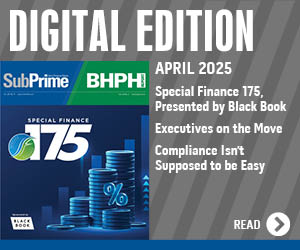BHPH Opportunities in the Alternative Financial Services Marketplace
HOUSTON — Everyone knows how important banks and financial institutions are to our national economy and to the capital markets. However, few people are aware of another emerging market called "alternative financial services," which now includes an estimated 80 million unbanked or underbanked consumers. What is the alternative financial services marketplace? The following table illustrates what services are included:
Type of Services:
Check Cashing: 22% (marketshare)
Pawn Lending: 22%
Rent-to-Own: 7%
Payday Lending: 10%
Installment Lending: 5%
Buy-Here, Pay-Here Auto Sales: 24%
Title Pawn and Other: 10%
It is estimated that the alternative financial services market now aggregates more than $321 billion, according to Stephens Inc., Investment Bankers. If the size of this market surprises you, consider the following:
— Approximately 10 percent of the U.S. population (30 million Americans) do not have checking accounts.
— Approximately 26 million Americans make less than $25,000 per year.
— Approximately 28.4 percent of all unbanked consumers do not write enough checks to have a bank account.
— An estimated 25 percent of the U.S. population has a credit score of less than 600 or no credit score at all.
Where do all these credit challenged customers come from?
1. Consumers who were formerly banked but had a negative credit experience (like bankruptcy, repossession, etc.) or account termination, and don't qualify for traditional loans. These consumers have limited transportation alternatives.
2. Immigrants who don't use banks.
3. Consumers who need credit alternatives to make ends meet.
4. Consumers who live paycheck to paycheck.
5. Convenience-driven consumers who need extended hours and financial services not offered by banks.
6. Those who require close proximity to their home or job.
As mentioned earlier, buy-here, pay-here auto sales provide 24 percent, or approximately $77 billion, of the financing in this market. Last year, according to the National Independent Auto Dealers Association, independent dealers sold approximately 14.2 million vehicles and about 56 percent of these sales were finance deals.
The aforementioned information suggests that there is no apparent shortage of BHPH customers, so then, what is the challenge? Simply stated, to prosper in the BHPH industry requires the skill of managing the collection risk associated with a subprime portfolio and not in merely selling used vehicles.
There are three key elements in every BHPH finance deal: the customer, the vehicle and the proper deal structure. However, all three elements are critically important to the ultimate success of each deal. Therefore, all BHPH operators must do the following to prosper:
1. Underwrite each deal prudently and put the right customers in a vehicle which they can afford.
2. Implement a business model (which is limited by capital availability) but which maximizes profits and cash flow.
3. Implement sound systems and processes to operate efficiently and profitably. An emphasis must be placed on collections, which provides the cash flow for working capital and to repay debt. A good collection operation is 70 percent of a successful BHPH operation.
4. Provide each customer with a total transportation solution that includes keeping the vehicle running over the term of the installment contract. This often requires financing significant repairs after the initial sale.
5. Train and develop key personnel who are needed to grow and manage the portfolio successfully.
Success in the BHPH business also necessitates avoiding fatal legal and regulatory mistakes which can cause an otherwise successful operation to fail. Large and small operations alike are more susceptible to these compliance pitfalls when operators don't take the time to properly educate themselves on all of the various federal, state and local legal and regulatory requirements.
The BHPH business is very capital intensive. Therefore, dealers must spend every dollar prudently in order to prosper. Every finance deal starts with negative cash flow ("money on the street"). Therefore, making trial-and-error mistakes in building a portfolio can cost a dealer millions of dollars in losses.
Given all the aforementioned challenges, those who are considering the BHPH business are encouraged to:
1. Read all available industry trade publications and understand current developments which will affect their business.
2. Obtain the necessary national, state and local training to avoid the fatal industry compliance pitfalls.
3. Assemble a team of professionals which must include a knowledgeable lawyer, CPA and lender.
4. Locate the appropriate dealer management software system to grow and manage a portfolio.
5. Hire or develop an experienced management team which won't squander precious capital via trial and error.
6. Implement sound operations, systems and practices and monitor performance.
7. Accurately estimate the capital requirements needed and obtain the required capital before starting.
8. Network with other successful dealers in order to develop the best practices.
Although the challenges above are formidable, the rewards are great. Dealer education and networking will significantly shorten your learning curve. Good luck!
Kenneth B. Shilson, CPA, is a principal in Shilson, Goldberg, Cheung & Associates LLP and is president of Subprime Analytics, which performs electronic portfolio analysis. Mr. Shilson is also the founder of the National Alliance of Buy Here Pay Here Dealers, which will host a BHPH Collection Academy near Atlanta, Ga., at the Manheim DRIVE Center, Jan. 9-11, 2007. Collection and underwriting practices will be discussed in detail at the Collection Academy. For further information, visit the NABD Web site at www.bhphinfo.com, or call (713) 290-8171.


